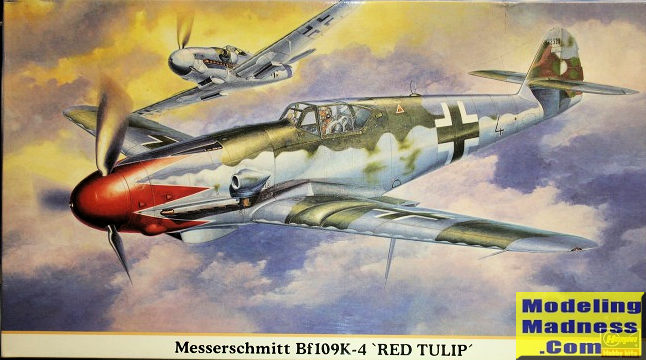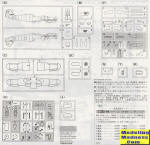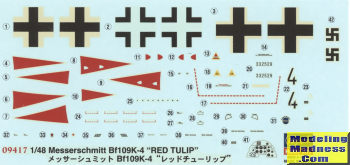
Hasegawa 1/48 Bf-109K-4 'Red Tulip'
| KIT #: | 09417 |
| PRICE: | 2400 yen when new |
| DECALS: | Two options |
| REVIEWER: | Scott Van Aken |
| NOTES: | 2002 Limited Edition |

| HISTORY |
The Bf 109K was the last of the series to see operational duty and the last in the Bf 109 evolutionary line. The K series was a response to the bewildering array of series, models, modification kits and factory conversions for the Bf 109, which made production and maintenance complicated and costly – something Germany could ill-afford late in the war. The RLM ordered Messerschmitt to rationalise production of the Bf 109, consolidating parts, types, and so on, to produce a uniform, standard model with better interchangeability of parts and equipment. At the same time, the existing flaws of the design were to be remedied. Work on the new version began in the spring of 1943, and the prototype was ready by the autumn of that year. Series production started in August 1944 with the K-4 model, due to changes in the design and delays with the new DB 605D powerplant. The K-4 was the only version to be mass-produced.
Externally the K series could be identified by changes in the locations of the radio equipment hatch, which was moved forward and to a higher position between frames four and five, and the filler point for the fuselage fuel tank, which was moved forward to a location between frames two and three. In addition, the D/F loop was moved aft to sit between frames three and four on the top fuselage spine and a small circular plate above the footstep on the port side of the fuselage was deleted. The rudder was fitted as standard with a Flettner tab and two fixed tabs although some rare examples were not fitted with the fixed tabs. All K-4s were to be fitted with a long retractable tailwheel (350 × 135 mm/14 × 5 in) with two small clamshell doors covering the recess when the tail-wheel was retracted.
The wings featured the large rectangular fairings for the large 660 × 190 mm (26 × 7 in) main wheels. Small wheel well doors, originally planned for the G series, were fitted to the outer ends of the wheel bays, covering the outer wheels when retracted. These doors were often removed by front-line units. The radio equipment was the FuG 16ZY with the relocated main swept-forward radio antenna under the portside wing from the G-10 being carried through as the standard for the K-series airframes. The FuG 25a Erstling IFF system, as well as the FuG 125 Hermine D/F equipment were also fitted. Internally, the oxygen bottles were relocated from the rear fuselage to the right wing. Flettner tabs for the ailerons were also to be fitted to serial production aircraft to reduce control forces, but were extremely rare, with the majority of the K-4s using the same aileron system as the G series.
Armament of the K-4 consisted of a 30 mm (1.18 in) MK 108 engine-mounted cannon (Motorkanone) with 65 rounds, and two 13 mm (.51 in) MG 131s in the nose with 300 rpg although some K-4s were fitted with the MG 151/20 as the Motorkanone. Additional Rüstsätze, or equipment kits, such as a 300 L (80 US gal) drop tank (R III), bombs up to the size of 500 kg/1,100 lb (R I), underwing 20 mm Mauser MG 151/20 cannon gondola pods (R IV) or 21 cm (8 in) Wfr.Gr. 21 rockets (as on the Gustav models) could be carried after minimal preparations; the latter two however were rarely used by Bf 109 units at this stage of the war, although III./JG 26 were almost completely equipped with K-4s which were fitted with R IV:
...apparently all of the K-4s supplied to III./JG 26 were also equipped with 20 mm-guns in the hated underwing tubs. Uffz. Georg Genth's regular aircraft was a G-10, but on occasion he flew a K-4. He preferred the G-10 as a dogfighter, as the K-4's bulky armament sharply reduced its manouevrability.
In addition there were problems with the 30 mm (1.18 in) MK 108 Motorkanone, which often jammed while the aircraft was manouevring in battle, leaving the pilot to fight on with the two heavy machine guns. The standard Revi 16C reflector sight was fitted, which was slated to be replaced later by the EZ 42 Gyro gunsight, although this never happened.
Power was provided in production K-4s by a Daimler-Benz DB 605DB/DC engine (very early K-4s used the earlier DM).The DB/DC engine had an adjusting screw allowing the engine to use either B4 + MW 50 Methanol Water injection equipment or C3 fuel (DB 605 DB) or C3 fuel, with or without MW 50 (DB 605 DC). Using B4 fuel with MW 50, the DB generated an emergency power rating of 1,600 PS at 6,000 m (1,160 PS maximum continual at 6,600 m), and take-off power of 1,850 PS at 0 m, with a maximum supercharger boost of 1.8 ata. The DB could also be run on higher octane C3 fuel, but use of MW 50 was forbidden. The DC ran on C3 fuel and could generate a potential 2,000 PS, but only when using C3 fuel with MW 50 and a boost of 1.98 ata, otherwise the power ratings were similar to that of the DB. A wide-chord, three-bladed VDM 9-12159A propeller of 3 m diameter was used, as on the G-6/AS, G-14/AS and G-10.
Deliveries began in mid-October 1944. 534 examples had been delivered by the Messerschmitt A.G., Regensburg by the end of November 1944, and 856 by the end of the year. Regensburg delivered a total of 1593 by the end of March 1945, after which production figures are missing. With such a high rate of production, despite continuous heavy fighting, by the end of January 1945 314 K-4s – about every fourth 109 – were listed on hand with the first line Luftwaffe units. Ultimately it was intended to equip all Bf 109 units with the 109K, which marked the final stage of 109 development before the jet age.
Using MW 50 and maximum boost the Bf 109 K-4 was the fastest 109 of World War II, reaching a maximum speed of 710 km/h (440 mph) at 7,500 m (24,610 ft) altitude. Without MW 50 and using 1.80 ata the K-4 reached 670 km/h (416 mph) at 9,000 m (26,528 ft). The Initial Rate of climb was 850 m (2,790 ft)/min, without MW 50, and 1,080 m (3,540 ft)/min, using MW 50.
The Bf 109 remained comparable to opposing fighters until the end of the war. However, the deteriorating ability of the thousands of novice Luftwaffe pilots by this stage of the war meant the 109's strengths were of little value against the numerous and well-trained Allied fighter pilots.
| THE KIT |
 Those
used to Hasegawa's round wing 109s will immediately notice that some of the
sprues are the same throughout the F-K range. Particularly the wings, the one
with gear doors and flaps, and the one with the landing gear, exhaust and
spinner. All the rest are subject to change, depending on which variant is being
kitted.
Those
used to Hasegawa's round wing 109s will immediately notice that some of the
sprues are the same throughout the F-K range. Particularly the wings, the one
with gear doors and flaps, and the one with the landing gear, exhaust and
spinner. All the rest are subject to change, depending on which variant is being
kitted.
In this case we have the sprue for the K that includes new cockpit sidewall, oil cooler, prop blades, instrument panel, and fuselage to name most of the bits. Smaller sprues provide the new wheels and wheel fairings, clear bits, and the tailplanes with what look like reinforcements. Were this an Eduard kit, we'd have a lot more in terms of spares, but that is not how Hasegawa operates.
One will have to do a bit of additional work to square off the wheel wells and to open holes in the upper wing for the wheel fairings. Since filling the fairing holes will be difficult once the lower wing is installed, perhaps one will want to attach those early before closing the wing halves.
Everything else is old favorite stuff. A nice cockpit, though not as detailed as a replacement resin version, and a canopy that can be displayed open. Interestingly, Hasegawa does not show the drop tank being used. I ran into this with one of their other K boxings and have to tell you that the aircraft did use it, though you want to use the later version.
 Standard
stuff also for the instructions with Gunze color references. The markings
options are basically the same airplane, one prior to adding the aircraft number
from the look of it. This non-box art option also does not have a serial number
on the fin. The aircraft is with JG 52 and is probably supposed to be one of
Eric Hartman's planes as he often equated with the 'tulip' nose markings. Kit
decals are old school with off white whites, but should still be viable, even
after 15 years. Use hot water on these to get the best out of them. You also
have to paint the inside of the fuselage insignia with RLM 83, not an easy task
as the sheet has them in black. Colors given are RLM 83/75/76 with RLM 81 on the
fin and rudder.
Standard
stuff also for the instructions with Gunze color references. The markings
options are basically the same airplane, one prior to adding the aircraft number
from the look of it. This non-box art option also does not have a serial number
on the fin. The aircraft is with JG 52 and is probably supposed to be one of
Eric Hartman's planes as he often equated with the 'tulip' nose markings. Kit
decals are old school with off white whites, but should still be viable, even
after 15 years. Use hot water on these to get the best out of them. You also
have to paint the inside of the fuselage insignia with RLM 83, not an easy task
as the sheet has them in black. Colors given are RLM 83/75/76 with RLM 81 on the
fin and rudder.
| CONCLUSIONS |
I got this kit second hand with the cockpit bits already painted RLM 66, however, Hasegawa 109Ks are somewhat difficult to find so considered the price I paid to be a pretty good deal. Apparently the K version is not all that popular as Hasegawa has not produced a zillion limited editions of this variant. There is and has been a lot of aftermarket for this kit, so those wanting that little bit of additional detail, can easily get it.
| REFERENCES |
https://en.wikipedia.org/wiki/Messerschmitt_Bf_109_variants#K-4
June 2017
Copyright ModelingMadness.com. All rights reserved.
If you would like your product reviewed fairly and fairly quickly, please contact the editor or see other details in the Note to Contributors.
Back to the Main Page Back to the Review Index Page Back to the Previews Index Page